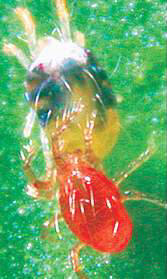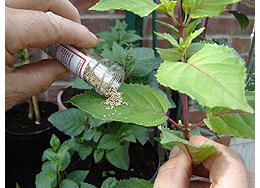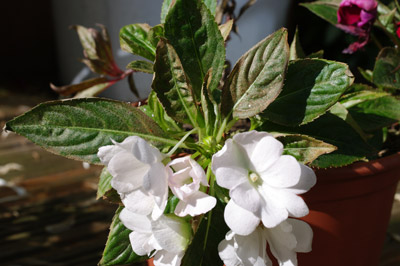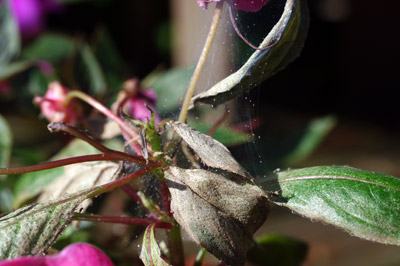Red Spider Mite - plant pest
Signs - Leaves become speckled, as though covered with hundreds or thousands of pale yellow dots giving a rather ill-looking and "dusty" appearance. Heavily infested plants may become covered with fine webs which can be more obvious than the mites themselves. Red spider mites are eight legged animals less than 1mm long and can be difficult to see.An infestation results in the leaves drying up and falling off, leaving only young leaves at the ends of shoots. Most often affect plants indoors or under glass, but will also attack many ornamental plants outdoors in a hot dry summer.
Damage - Sap feeders which weakens the plant. Usually a problem in house and greenhouse plants as they like a dry atmosphere.
Treatment - Red spider mites breed in hot and dry places. If you can increase the humidity around the plant you decrease the pest's reproduction rate. In greenhouses and patio areas the floors can be damped down. For house plants a short holiday somewhere cooler and more humid - the bathroom or even outside in the warmer months may help get rid of the infestation, especially if they get rained on.
-
I've been having trouble with Red Spider Mite in my conservatory
for a couple of years, using conventional and biological
pest control. I then tried your idea of spraying infected
plants with ice water. Brilliant results! - Thanks
Jon Willis - by email
 Biological
control. The biological control of a pest relies
on introducing a predator species so "fighting nature with nature",
if chosen carefully, the predator will stop damage to your plants
without damaging the environment. Such biological controls are
organic, safe for the user, children and pets. They will not
harm other beneficial garden insects and are biodegradable.
Biological
control. The biological control of a pest relies
on introducing a predator species so "fighting nature with nature",
if chosen carefully, the predator will stop damage to your plants
without damaging the environment. Such biological controls are
organic, safe for the user, children and pets. They will not
harm other beneficial garden insects and are biodegradable.They do rely on the predator always having some food though, or they will die out, so like other organic practices it is a question of maintaining a small population of pests to allow the predators to be ready for them, in this case though the balance is skewed away from the problem.
The predatory mite; Phytoseiulus
permilis is
used. This species reproduces at twice the speed of red spider
mite at 18°C (64°F). The Phytoseiulus mite eats only
Red spider mite and each one can eat many hundreds of them.
Whilst feeding on Red spider mite, Phytoseiulus will
also reproduce laying many eggs which will hatch into more predators.
Phytoseiulus is similar in appearance to red spider mite
but is more red in colour and moves much faster.
Phytoseiulus
is suitable for glasshouse or conservatories and can be used
on strawberries and other susceptible fruit from May to August
outside.

Insect
hotel / house
A sheltered insect house to help a range of beneficial
insects to over-winter in your garden. If they are over-wintering there,
they are in an ideal position come the spring and summer to wake up and
help to combat any pests you may have. Amongst others, good for ladybirds,
lacewings and solitary wasps which will help keep your unwanted garden visitors
down. Place in a sheltered place outdoors.

Biological
Pest Control - Organic living pest control for a variety of
problems, red spider mite, whitefly, fungus gnats (sciarid fly), thrips, mealy bug,
vine weevils and more.
These are parasites or predators that will specifically infect the pest they are brought in to control without harming any other living things and without the use of chemicals. A small population of pests needs to be maintained so that the control agent doesn't die out.

Chemical insecticides - If your plants get a heavy infestation, then I think it's acceptable to use a chemical insecticide as a "smart missile" just on that particular plant. I resort to this when the aphids build up under cover on my favourite plum tree, or other plant/s. Don't overdo it and spray too often and don't spray the whole garden "just-in-case", buy a small 1L or thereabouts sprayer so you don't get carried away.
Not pest specific.
Q. Could you refresh my memory I'm looking for something to spray my 3 year old Gordon apple trees. Something in my brain keeps telling me now is the time to do it but what with. Last year we suffered with tiny red Spiders etc.
A. It sounds like you had the dreaded red spider mite, a common pest on a whole variety of garden and house plants and frequently found on apples. I'm not aware of anything that you can spray in the dormant season to rid yourself of these. Most control methods involve spraying as soon as you see them.
There are a number of pesticide resistant strains these days. The best bet is to keep a careful eye on your tree and spray at the absolute first sign of infestation. The pesky little critters have a very high rate of reproduction and can soon reach high densities.
Malathion, or similar insecticides work but must be sprayed at 3 - 5 day intervals. The real secret to beating these as many other pests is to get them quickly and before they establish. In the summer I usually keep a small spray of insecticide permanently made up to blast these and other pests such as aphids with as soon as I see them.
You need to make sure that the spray actually reaches them all. I know it sounds obvious, but they hide under leaves and make fine webs over themselves that even fine spray drops don't always pass through.
There is a predatory mite that you can buy as a means of biological pest control that has very good results if used at the right time, and they can't get resistant to that!
Copyright 2000 - present. All Rights Reserved | Privacy Policy Statement


